
My name is Tracy Hoffman and I’m a grid supervisor on the Leon Levy Expedition to Ashkelon. As one of the longest serving members of the expedition team it is with some trepidation and even more excitement I take on the task of sharing Ashkelon with the world.
I first volunteered in 1989. I had just finished my freshman year of college and was eager to embark on the discovery of the hidden glories of the ancient past. Glories that I quickly discovered were not always hidden nor particularly gorgeous or even that ancient if it comes down to it. It is unfortunate, albeit sometimes gratifying and satisfying, that we don’t get to choose what impresses us, to hand select the memories that leave an indelible imprint on our life’s journey. If it were possible I would undoubtedly consider exchanging some of my earliest memories of Ashkelon...
My first few summers at Ashkelon were an adventure as might be expected of any “once in a lifetime” experience. One of my roommates, and there were four of us in one room, was adverse to shaving and had a propensity for sleeping in the nude. One of my fellow volunteers managed to drawl his one syllable name into three, sometimes four syllables leaving most of us confused about what his name actually was until halfway through the season when we were able to determine the two key letters that made up his name. There were a pair of supervisors who were affectionately referred to as “the Greek god” and “the Norse god” for their imagined resemblance to the oh so handsome, deities of old.
There were our accommodations which featured roaches (larger than any I had ever seen before and they moved fast), late night pool parties with hotel guests staying up into the wee hours of the night listening to the Chicken Dance on a seemingly endless loop. And, of course, there was the food which was always filling if not wholly satisfying.
Through it all there was the archaeology, the exploration of the ancient city of Ashkelon and its hidden glories. Which for me, that year and the next, meant an inordinate amount of time in sewers. Large or small, little more than rivulets running down the center of a dirt street or purpose built stone drains I experienced it all. And by the end of my first two seasons of sewer excavation I was convinced (and still am truth be told) that a rehydrated sewer, one newly re-exposed to the humid Mediterranean air, retained discernible vestiges of its former odoriferous glory. In other words, they still stank when the wind was blowing the right way.
Over the years I have excavated a wealth of archaeological material from those sewers to houses, warehouses, streets, burials and so much more. Along the way I have encountered a bewildering array of interesting people from those who didn’t like the sun and those afraid of bugs to students of history, archaeology and religion not to mention those more mature adults embarking on the adventure of a lifetime to borrow and repeat an apt, oft spoken cliche.
Ashkelon is many things to many people and as my thoughts turn to the upcoming 2010 season I can’t wait the meet the next group of hardy souls willing to take the 5:00 AM ride from the Gani Dan to the ancient city. With staffing well under way and discussions about excavation strategy and planning heating up it is only a matter of time before the months become weeks, and the weeks become days and the days become the morning after a really long plane ride. If the spirit of adventure moves you, come join us.
If you’re new to our site take a look at the National Geographic January 2001 issue where ancient Ashkelon is a feature article. Head to the library and peruse Ashkelon I, a comprehensive overview of the first season of excavation in 1985, edited by Lawrence Stager, David Schloen and Daniel Master. Or stay tuned to this blog where I’ll pass along interesting tidbits on the daily life and times, not to mention the amazing archaeological research, of the Leon Levy Expedition to Ashkelon.
For those of you who aren’t new, something I’ll call “What, where, when?” Can you identify what’s in the picture to the right?
To learn more about the site, our research and volunteer opportunities please go to www.fas.harvard.edu/~semitic/ashkelon/. Send questions to leonlevyexpeditiontoashkelon@gmail.com.
Thanks and see you next time!


















































